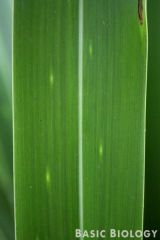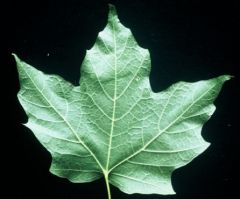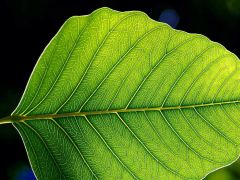![]()
![]()
![]()
Use LEFT and RIGHT arrow keys to navigate between flashcards;
Use UP and DOWN arrow keys to flip the card;
H to show hint;
A reads text to speech;
55 Cards in this Set
- Front
- Back
|
Green Plants produce their own food, and therefore are called what? |
Producers |
|
|
Consumers are living things that do what? |
Eat plants or other consumers |
|
|
Plants use what to produce food by photosynthesis? |
Chlorophyll |
|
|
What is the equation for Photosynthesis? |
Light+6CO2+6H2O yields C6H12O6+6O2 |
|
|
What is the equation for Cellular Respiration? |
C6H12O6+6O2 yields 6CO2+6H2O+Energy |
|
|
What is the opposite of Photosynthesis? |
Cellular Respiration |
|
|
What is the main purpose of plants according to Gen. 1: 29-30? |
Food for people and animals |
|
|
True/False: The general shape or form of of an organism is called its morphology. |
True |
|
|
Most plants have how many main structures? |
4 |
|
|
List a plants main structures: |
Roots, stem, leaves, flowers |
|
|
Plant organs are determined by their relationships to what? |
Nodes |
|
|
True/False: A node is where the root meets the stem of a plant. |
False |
|
|
What is a node? |
The places where leaves are/were attached to the stem |
|
|
What is a root system? |
All the roots of a plant |
|
|
What is one major root type? |
Tap Root system |
|
|
What is one major root type? |
Firbous Root system |
|
|
Describe a Tap Root system: |
The primary root grows straight down and remains larger that the secondary roots. |
|
|
Describe a Fibrous Root system: |
Secondary roots grow in all directions and may be as long as the primary root. |
|
|
Name one main type of stem: |
Woody- hard and not very flexible |
|
|
Name one main type of stem: |
Herbaceous- soft and more flexible |
|
|
The flat, green part of the leaf is called what? |
The blade |
|
|
Most leaves are what? |
Simple leaves |
|
|
What is a leaf that looks like many smaller leaves called? |
Compound leaves |
|
|
True/False: The smaller pieces of a leaf are called leafettes. |
False. |
|
|
What are the smaller pieces of a compound leaf called? |
Leaflets |
|
|
What is a vein? |
A water conducting tissue |
|
|
There are how many main types of veination? |
3 |
|
|
What does Parallel Veination look like? |

|
|
|
What does Palmate veination look like? |

|
|
|
What does Pinnate veination look like? |

|
|
|
What stiff structures surround plant cells? |
Cell Walls |
|
|
Cell walls are made of mostly what? |
Cellulose |
|
|
Water pressure inside plant cells is called what? |
Turgor pressure |
|
|
Xylem carries what toward the sky? (Hint: 🎶) |
Minerals and Water |
|
|
Phloem carries what on down? (Hint: 🎶) |
Food (water and dissolved sugar) |
|
|
Xylem and Phloem are usually arranged in what? |
Vascular Bundles |
|
|
The oldest Xylem is where in a woody stemmed plant? |
The center |
|
|
Old dead Xylem is called what? |
Heartwood |
|
|
Xylem that is still alive and carrying water is called what? |
Sapwood |
|
|
What are tree rings, and how are they made? |
Each year a tree adds new xylem. This annual growth results in tree rings. |
|
|
What colors coordinate to what seasons? |
Light- Spring Dark- Summer/Fall |
|
|
If there is plenty of sunshine and water, the light rings will be... |
Larger than those produced during dry seasons |
|
|
Name the first of the 3 key steps in transporting water in plants: |
Entrance through the roots |
|
|
The second key step in transporting water in plants: |
Transport through the Xylem |
|
|
The third key step in transporting water in plants: |
Exit through the leaves |
|
|
Water and dissolved minerals are absorbed into the root near the root tip. Then... |
...they travel up through the Xylem |
|
|
The special openings on the underside of most leaves are called what? |
Stomata |
|
|
True/False: Stomata allow gasses and water vapor to pass in and out of the leaf. |
True |
|
|
Special cells called ____ are arranged in pairs around the stomata. |
Guard Cells |
|
|
Water exiting the plant through the stomata is called what? |
Transpiration |
|
|
The growth responses of a plant to its environment are called what? |
Tropisms |
|
|
If a plant grows toward an environmental factor, it is called what? |
Positive tropism |
|
|
If a plant grows away from an environmental factor, it is called a what? |
Negitive tropism |
|
|
Be able to explain Positive Phototropism, as well as Positive and negative tropisms. |
Happy studying! |
|
|
Photoperiodism is: |
A plant's response to the length of time it is exposed to light. |

